Ex Tax: 0.70€
A very popular early ripening variety in America: 22-28 days from germination to harvest.
Root crops are cherry-red, round, up to 2.5 cm in diameter. The pulp is snow-white, crispy and without bitterness.
Ideal for early or late sowing indoors.
* They have grown radishes in many parts of the world, and in the Mediterranean (the homeland of radishes) for over 4000 years.
Radish was one of the cultivated plants that were grown on the International Space Station in order to study the development of plants in zero gravity. Radish was chosen both for its short growing season and for the fact that both the root vegetable and its leaves can be eaten, which is extremely important when growing the plant in space.
Surprisingly, the healthiest part of a radish is its tops, which are crushed and used as salad greens and added to soups, side dishes, boiled and stewed meats.
Green leaves contain all the properties of radish, and in a more concentrated form (!).
The radish tops have a pleasant spicy taste, which also gives the dish a rich color.
"Radish" is a rich source of vitamins and minerals, which is especially important in early spring, when there are still very few other fresh vegetables. It contains vitamins C, B1, B2, B5, PP, potassium, calcium, sodium, magnesium, phosphorus and iron. Radishes also contain sugars, enzymes, fiber and vegetable fats.
This vegetable, useful in all respects, increases immunity and the level of hemoglobin in the blood. In addition, "radish" enhances metabolism, increases appetite and improves digestion due to its high fiber content.
In addition, the increased content of natural phytoncides makes radishes an excellent antibacterial agent: radish salad will not only help to avoid colds, but, if it has already occurred, will speed up recovery.












